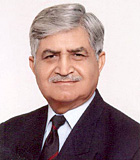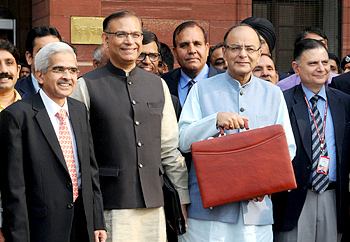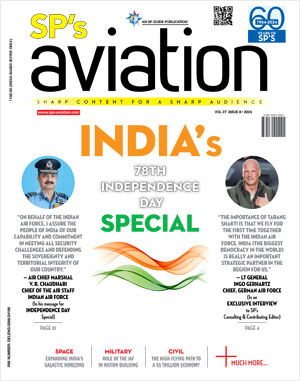INDIAN ARMED FORCES CHIEFS ON OUR RELENTLESS AND FOCUSED PUBLISHING EFFORTS

SP Guide Publications puts forth a well compiled articulation of issues, pursuits and accomplishments of the Indian Army, over the years

"Over the past 60 years, the growth of SP Guide Publications has mirrored the rising stature of Indian Navy. Its well-researched and informative magazines on Defence and Aerospace sector have served to shape an educated opinion of our military personnel, policy makers and the public alike. I wish SP's Publication team continued success, fair winds and following seas in all future endeavour!"

Since, its inception in 1964, SP Guide Publications has consistently demonstrated commitment to high-quality journalism in the aerospace and defence sectors, earning a well-deserved reputation as Asia's largest media house in this domain. I wish SP Guide Publications continued success in its pursuit of excellence.
Are Our Politicians Losing Interest in India’s Defence?
 |
By General V.P. Malik (Retd) Former Chief of the Army Staff |

The Standing Committee on Defence, headed by BJP member Major General BC Khanduri, has recently conveyed to the Parliament that the ‘growth in the budgetary allocation for defence is not sufficient and woefully inadequate for modernisation.’ This assessment cannot be a surprise to anyone, except those who have stopped taking interest in India’s defence requirements.
After Kargil war,during which I made that famous statement “We shall fight with whatever we have”, India’s defence budget was raised to 2.41 per cent of its GDP. Since then,there has been a steady downslide, to 1.47 per cent this year, not counting the thousands of crores surrendered by the Ministry of Defence near annually. So the Defence Secretary G Mohan Kumar wasabsolutely right when he admitted before the parliamentary panel that India’s military spending for FY 2016-17 is not as per the requirements of the services.
A question linked to the above-mentioned observationwould be, ‘Are the government and political parties losing interest in India’s defence?’
I believe so: not only the NDA regime but all political parties seem to be losing interest in India’s defence matters when one notices that only ten out of 24 political parties had given their views in this report of the Parliament Standing Committee on Defence.
As an armed forces veteran, I noticed two firsts in the Annual Budget presented to the Parliament this year.
First, the Finance Minister Arun Jaitley never mentioned the word ‘defence’ in his speech. I cannot recallthat happening in the last five decades or more. In the Budget 2014-15, there was a cryptic reference to the ‘Make in India’ programme in defence self-reliance. This year, there was not even that. To many people, this lack of mention would have conveyed the impression that India’s security and 3.4 lakh crore of India’s defence budget (total defence outlay plus the pensions bill) is of little importance.
Second, for the first time, the Finance Minister included ‘defence pensions’ as part of Defence Ministry Allocation (Item no. 21 in the Summary of Demands for Grant). Till now, military pensions were never a part of defence budget. It was a separate allocation. The Finance Minister included this expenditure as part of the defence budget probably for two reasons:
- To convey that this particular item has impacted the rest of defence allocation (military pensions are likely to increase from 60, 238 crores in FY 2015-16 to 82, 332 crores in FY 2016-17).
- To convey that total defence outlay has been increased substantially.
What is the actual defence allocation for this year? What are its implications for the armed forces? Let me analyse and state my views.
The defence allocation sought in the budget estimate (BE) for the FY 2016-17 is: Revenue-148498.85 crores, Capital-78586.68 crores, Pensions-82332.66 crores, Miscellaneous (other than armed forces)-68537.63 crores. On the basis of BE of last year, there is an increase of mere 1.16 percent. This allocation does not even cover India’s inflation rate and will be insufficient to fulfil military’s basic needs, let alone its modernisation.
In the FY 2015-16, the Ministry of Defence was unable to spend 18295 crores out of it's allocated budget. This included 11595 crores from the Capital expenditure, or 13.4 percent of the funds earmarked to purchase new military equipment. The rest unspent amount was from Revenue expenditure, mostly maintenance requirements of the military. For the unspent money, which leads to reduction in the Revised Estimates (RE) year after year, we can blame the Ministry of Defence for its cumbersome procedures, and also its Finance Advisor who takes his cues on curtailing defence expenditure from the Ministry of Finance. Usually, he is seen to be more loyal to his parent ministry than the one in which he is located.
For the FY 2016-17, the capital expenditure outlay for the armed forces is 78,586.68 crores. Last year, at the BE stage, it was 85,894.44 crores. This clearly implies lesser money for modernization this year. Of the allocated amount, more than 80 per cent funds are expected to be paid for deals which have already been signed.
Lack of funds will force the Defence Ministry to cancel several projects, and even withdraw some already floated tenders. The delays in the replacement of the army’s obsolescent weapons and equipment, making up of deficiencies in fighter squadron strengthof the air force and the submarine fleet of the navyto meet future threats and challenges is indeed worrisome. Several big ticket purchases being worked out for modernization of the army, navy and air force are likely to suffer. This would also affect our defence industrial sector which is looking for expansion and more supply orders as part of India’s ‘Make in India’ programme.
Everyone knows that India’s defence modernisation had suffered heavily during the UPA regimes which ordered probes into every charge of corruption and blacklisted suspect defence vendors. The blacklisting went to such an extent that at one stage almost every defence industry company in the world stood banned. In fact, the NDA came to power accusing the UPA for its overcautious defence minister A.K. Antony neglecting the military,and promised to make India stronger.
The maintenance (Revenue) expenditure is no less a worry. The allocation this year-148498.85 crores which is an increase from last year’s BE 137153.03 crores. The fact is that this expenditure has been bloating year after year and thus skewing maintenance versus modernization ratio in defence allocation. Ideally, it should be about 50:50 for the air force and navy, and about 65:35 for the manpower intensive army.
In the past, whenever Revenue expenditure overshot the budgeted allocation, there was a tendency to dip into the Capital expenditure. This year, with extra revenue expenditure required on account of 7th Pay Commission recommendations, and post Pathankot attack extra security measures for large defence installations, I doubt if we can come anywhere close to these ratios next year.
I have four additional comments to make.
- As a ratio of projected GDP for the FY 2016-17, India’s defence expenditure will be around 1.47 per cent. In comparison, China spends more than 2.5 per cent, and Pakistan around 3.5 per cent of their respective GDP. India’s per capita expenditure on defence is less than USD 10, while the average expenditure of the top ten spenders in Asia is approximately USD 800. Given India’s increasing vulnerabilities and international demands to act as a net provider of security as a rising regional power, the defence allocation and expenditure needs to be supplemented to create the capabilities which the armed forces will need in future.
- The inability to spend allocated capital modernization budget must be rectified urgently. We should re-consider ‘non-lapsable, roll-on allocation’ for defence capital budget. This was instituted by the last NDA Government under Atal Bihari Vajpayee.
- While seeking additional resources from the government, it is also the responsibility of the Ministry of Defence and the armed forces to control the ever bloating revenue expenditure. This requires stricter check over manpower expansion, with greater use of technology where necessary. With greater integration of services, we can cut down duplication (sometime triplication) of our non-combat resources.
- In order to meet Standing Committee’s observation on greater efficiency of spending, we should also institute a ‘technical audit’ every five years to check if the allocated capital resources have been utilized optimally for the desired capabilities.
In his speech to the Combined Commanders in December 2015, Prime Minister Modi said, “In a world of rapid changes, India faces familiar threats and new ones. Our challenges cover land, sea and air at the same time. It includes the full range, from terrorism to conventional threat to a nuclear environment.
Our responsibilities are no longer confined to our borders and coastlines. They extend to our interests and citizens, spread across a world of widespread and unpredictable risks.”
Surely, that could not be mere rhetoric?
There is a feeling amongst large number of armed forces personnel that the government, particularly the Finance Minister, was upset with some armed forces veterans’ continuing agitation over ‘One Rank One Pension’ issue despite the government conceding most of this demand. My appeal to the government is that whether that is true or not, it must not come in the way of the armed forces modernisation.
Photo Credit: PIB





